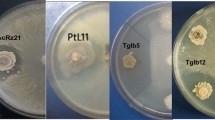Abstract
Repeated in vitro and in vivo trials were conducted to evaluate antifungal activity of chitosan against Rhizoctonia solani f.sp. sasakii (RSS) causal organism for banded leaf and sheath blight of maize. Different concentrations of chitosan (viz., 0.2, 0.4 0.6, 0.8 and 1 mg/mL) were evaluated under controlled environment. Maximum growth inhibition (57.5%) was recorded with chitosan 1 mg/mL. Growth of RSS was slowed down with repeated sub-culturing of tested fungus in chitosan-amended medium indicating fungistatic effect of the chitosan. An increased chitosanase activity was recorded when chitosan was supplemented in the growth medium as sole carbon source compared to variant with dextrose after 15 days of incubation. Transmission electron microscopy showed that chitosan caused cellular disorganisation, increased number of vacuoles and reduced appearance of protoplasts as compared to non-chitosan treatment in the mycelia of RSS. Under in vivo trials, chitosan significantly (P ≤ 0.05) reduced lesion length and intensity of the pathogen action when recorded after 7 days under polyhouse conditions. An increased activity of phenylalanine ammonia lyase, polyphenol oxidase and superoxide dismutase (defence enzymes) was also recorded in chitosan-treated maize plants. Thus, chitosan showed promising management potential against banded leaf and sheath blight of maize caused by RSS under in vitro and in vivo trials.





Similar content being viewed by others
REFERENCES
Hochholdinger, F. and Tuberosa, R., Curr. Opin. Plant Biol., 2009, vol. 12, pp.172–177.
Devi, B. and Thakur, B.R., Proc. Nat. Acad. Sci., India Sect. B Biol. Sci., 2018, vol. 88, pp. 769–777.
Singh, S.K., Patel, M.B., Thakker, B.N., Hooda, K.S. and Barad, A.K., Int. J. Curr. Microbiol. Appl. Sci., 2019. vol. 8, no. 7, pp. 2858–2866. https://doi.org/10.20546/ijcmas.2019.807.356
Stresses of Maize in Tropics, Zaidi, P.H. and Singh, N.N., Eds., New Delhi: Directorate of Maize Research, 2005, pp. 159–171.
Hooda, K.S., Khokhar, M.K., Parmar, H., Gogoi, R., Joshi, D., Sharma S.S., et al., Proc. Natl. Acad. Sci., India, Sect. B Biol. Sci., 2017, vol. 87, pp. 1041–1052. https://doi.org/10.1007/s40011-015-0688-5
Rabea, E.I., Badawy, M.E.T., Stevens, C.V., Smagghe, G., and Steurbaut, W., Biomacromolecules, 2003, vol. 4, pp. 1457–1465.
Rabea, E.I., Badawy, M.E.T., Steurbaut, W., and Stevens, C.V., Eur. Polym. J., 2009, vol. 45, pp. 237–245.
El-Hadrami, A., Adam, L.R., El Hadrami, I., and Daayf, F., Mar. Drugs, 2010, vol. 8, pp. 968–987.
Reddy, M.B., Angers, P., Castaigne, F., and Arul, J., J. Am. Soc. Hortic. Sci., 2000, vol. 125, no. 6, pp. 742–747.
Devlieghere, F., VermeuleA., and Debevere, J., Food Microbiol., 2004, vol. 21, no. 6, pp. 703–714.
Onaran, A., Bayar, Y., Karakurt, T., Tokatl, K., Bayram, M., and Yanar, Y., J. Taibah Univ. Sci., 2021, vol. 15, no. 1, pp. 852–860. https://doi.org/10.1080/16583655.2021.2006434
Mohammed, S.R., Zeitar, E.M., and Eskov, I.D., Open Agric. J., 2019, vol. 13, no. 1.
Hoang, N.H., Le Thanh, T., Sangpueak, R., Treekoon, J., Saengchan, C., Thepbandit, W., et al., Polymers, 2022, vol. 14, p. 662. https://doi.org/10.3390/polym14040662
Pandey, D.K., Tripathi, N.N., Tripathi, R.D., and Dixit, S.N., J. Plant Dis. Prot., 1982, vol. 89, pp. 344–349.
Liu, H., Tian, W., Li, B., Wu, G., Tao, Z., Wang, Y., et al., Biotechnol. Lett., 2012, vol. 34, no. 12, pp. 2291–2298.
Imoto, T. and Yagishita, K., Agric. Biol. Chem., 1971, vol. 35, no. 7, pp. 1154–1156.
Koukol, J. and Conn, E.E., J. Biol. Chem., 1961, vol. 236, no. 10, pp. 2692–2698.
Dhindsa, R.H., Plumb-Dhindsa, R. and Thorpe, T.A., J. Exp. Bot., 1981, vol. 32, p. 93101.
Manjunatha, G., Niranjan-Raj, S., Prashanth, G.N., Deepak, S., Amruthesh K.N., and Shetty H.S., Pest. Manage. Sci., 2009, vol. 65, pp. 737–743.
Manjunatha, G., Roopa, K.S., Prashanth, G.N., and Shetty, H.S., Pest Manage. Sci., 2008, vol. 64, pp. 1250–1257.
Shih, P.Y., Liao, Y.T., Tseng, Y.K., Deng, F.S., and Lin, C.H., Front. Microbiol., 2019, vol. 10, p. 602.
Al-Hetar, M.Y., Zainal Abidin, M.A., Sariah, M., and Wong, M.Y., J. Appl. Polymer Sci., 2011, vol. 120, no. 4, pp. 2434–2439.
ACKNOWLEDGMENTS
The first author is grateful to ICAR-Indian Agricultural Research Institute, New Delhi for the research facilities provided for the research work.
Author information
Authors and Affiliations
Corresponding authors
Ethics declarations
The authors declare that they have no conflicts of interest.
This article does not contain any studies with animals or human participants performed by any of the authors.
Rights and permissions
About this article
Cite this article
Balodi, R., Gogoi, R., Bisht, S. et al. Antifungal Activity of Chitosan Against Rhizoctonia solani f.sp. sasakii. Appl Biochem Microbiol 59, 323–329 (2023). https://doi.org/10.1134/S000368382303002X
Received:
Revised:
Accepted:
Published:
Issue Date:
DOI: https://doi.org/10.1134/S000368382303002X




